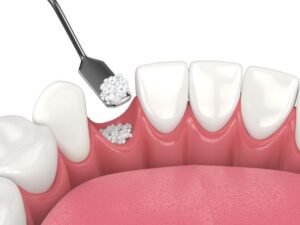
Dental implants are modeled after the structure of natural teeth; they rebuild lost dentition from the roots up. In order for them to be successful, they need a strong base in the jawbone. But what if your jaw is not up to the task of supporting implants? You might need to undergo a procedure known as a bone graft, which can fortify your jaw and establish the foundation for successful tooth replacement. Why is bone grafting so important, and how can you tell if you will need this procedure? Continue reading below to find out.
Why Might You Need a Bone Graft?
Bone grafting may be necessary if your jawbone is not strong enough or large enough to support dental implants. There are various reasons why your jaw may lack the required strength:
- The jawbone naturally deteriorates after tooth loss. The longer it has been since your natural teeth were extracted, the more likely it is that you will require a bone graft.
- Periodontal (gum) disease can lead to significant bone loss in the jaw. Even if you no longer have active gum disease, it may have caused serious harm to your bone.
- In some cases, natural bone structure may be insufficient. Genetic factors can affect the density and volume of your jawbone.
- Physical trauma, such as an accident that injured your facial structures, may have adversely affected your jawbone.
How Can You Tell if You Need a Bone Graft?
Your dental team will utilize advanced imaging equipment to learn about the condition of your jawbone. Here is what you can expect during this assessment:
- At your initial consultation, X-rays or other types of images will allow your dental team to look beneath your gumline.
- Your dentist will assess your bone density and volume to determine if it can support dental implants.
- Based on the findings, they will discuss the details of your bone grafting procedure, including the type of graft required and the expected outcome.
What to Expect with Bone Grafting
Bone grafting procedures can vary depending on individual needs and circumstances. There are different types of bone grafts, and the timing of the graft can also differ. Here are some general notes on what to expect:
- Some bone grafts are performed at the same time as dental implant placement. This approach may be suitable for patients with minor bone deficiencies that can be corrected at the same time as implant surgery.
- Other bone grafts are performed separately, a few months before dental implant placement. This allows time for the graft to fully integrate with the surrounding tissue.
- Follow-up appointments are essential to ensure the graft is successful and prepare you for the next steps in your dental implant treatment.
Regardless of the details of your bone graft, you can expect your care team to make you comfortable during your procedure with local anesthesia and/or sedation.
Bone grafting can play a crucial role in the success of your dental implants! Talk to your dental team to learn more about this procedure.
Meet the Practice
At Abington Family Dentistry, we are proud to help members of our community rebuild their smiles with dental implants. If you are curious about what it would take to replace your lost teeth, we would love to answer your questions during a FREE consultation. To learn more about us or to request an appointment, contact our office at 781-780-2658.
